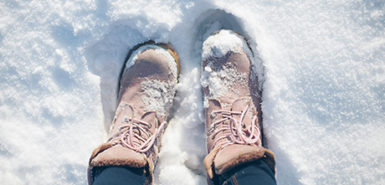
Outdoor activities in the winter can be for fun, or just a necessity.
Skiing, sledding or hiking? You’re probably having a blast. Shoveling the driveway, or headed to a parked car in any icy lot? Not so much fun.
Either way, the ice and snow pose significant dangers.
Being aware of the many types of injuries you could sustain is a first step to avoiding winter mishaps.
The most common accidents are slip and falls. The list of possible injuries—and their severity—is quite extensive. This can range from bruises and sprains to dislocated shoulders, broken bones and concussions.
“People slip and end up hurting an ankle,” said Brian Lee, PA-C, physician assistant with the division of orthopedic surgery at Spectrum Health Medical Group. “However, sometimes they may fall hard because they instinctively put their hands and arms out to catch themselves and they end up having more severe upper extremity injuries.”
For those participating in winter sports, such as snowboarding and skiing, slips and falls can involve a higher level of injury.
“Velocity plays a key role because the sports are high impact and speed can cause more serious injuries,” Lee said.
But the lion’s share of injuries is sustained by people just trying to negotiate slippery terrain.
“You spend all summer and fall walking in the normal fashion and then winter hits and you have extra elements to deal with—ice and snow,” he said.
Tread carefully
The most common winter activities often pose the greatest risk of injury. Show shoveling, for example, can cause problems if you’re not careful.
Shoveling improperly can lead to a range of injuries, from tendinitis to shoulder stiffness. Throw in a slip and fall while shoveling and you also face sprains and broken bones, said Patti Beggs, a Spectrum Health clinical athletic trainer.
The best way to deal with winter injuries? Avoid them. Take precautions and play it safe.
When shoveling snow, for example, take frequent rest breaks and, if possible, have someone help you.
Use your legs when lifting, as opposed to bending at the hip, Beggs said. This will take stress off your back.
Also, plan ahead and don’t try to get an outdoor job done too quickly. By taking your time, you’re more apt to keep caution top of mind.
If you venture out in the snow to hike or participate in an activity, make sure people know where you’re going. Carry a cell phone so you can call for help.
Beware of frostbite, too—wear proper gloves, socks and clothing, Beggs said.
As with most winter activities, proper stretching and warm-up are critical. And always stay hydrated.
“The key to avoiding winter injuries is always be prepared for your environment and error on the side of caution,” she said.
Grab that handrail
Stay observant about where you’re walking. Lee always recommends using assistive devices such as banisters, handrails or a cane—anything that can stabilize you while walking.
“I would also suggest that people, particularly older folks, buy—if they are economically able—boots that have good ankle support and traction,” Lee said.
If you’re already suffering from an injury, don’t take any chances. Stay off the ice.
If you’ve fallen and you think you’ve broken something or you hit your head, go to urgent care or an emergency department, Lee said.
“If there is any doubt as to the severity of the injury, then it needs to be evaluated by a medical professional,” Lee said.
If you’re absolutely certain you didn’t break a bone and you feel you can treat the injury with rest, place ice on the affected area and use a compression bandage on it. If it’s a leg or ankle that’s injured, elevate it.
 /a>
/a>
 /a>
/a>
 /a>
/a>